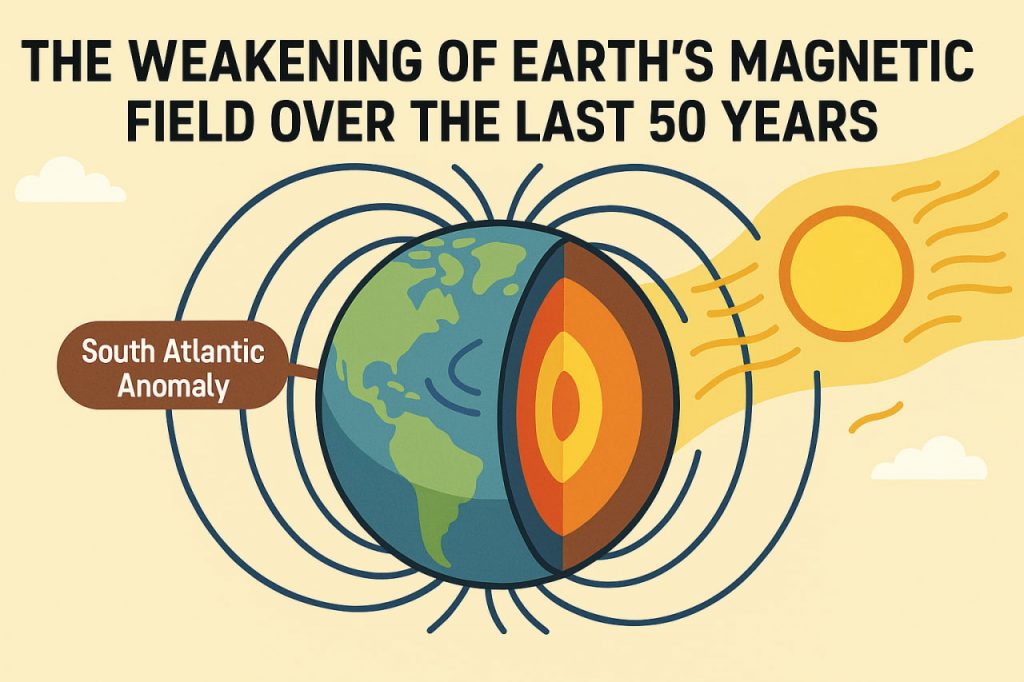The magnetic field of Earth is generated by the motion of molten iron and nickel in the outer core. This process, called the geodynamo, creates a protective shield around the planet. It deflects most of the solar wind and cosmic radiation, making life on Earth possible.
Observed Weakening in Recent Decades
Over the last 50 years, scientists have observed a steady weakening of Earth’s magnetic field by about 9–10% on average. One of the most notable regions is the South Atlantic Anomaly, where the field is especially weak. This phenomenon has raised concerns about long-term changes, including a potential geomagnetic reversal.
Causes of Magnetic Field Weakening
The exact causes are complex, but scientists suggest that irregular flows of molten metal in the outer core, combined with dynamic shifts in the geodynamo, are responsible. Local anomalies may also result from the interaction between Earth’s core and mantle.
Consequences for Technology
A weaker magnetic field means that satellites and spacecraft are less protected from radiation. This can lead to malfunctions in electronics, communication breakdowns, and reduced lifespan of satellites. Airplanes flying at high altitudes near the poles are also more exposed to radiation.
Impacts on Nature and Health
For most humans and animals on the surface, the atmosphere still provides strong protection. However, migratory animals that rely on the magnetic field for navigation — such as birds, turtles, and whales — may experience disorientation if weakening continues.
Could It Lead to a Pole Reversal?
Scientists note that the weakening of the field may be part of a natural cycle that eventually leads to a geomagnetic reversal, where the north and south magnetic poles switch places. Such reversals have happened many times in Earth’s history, though the process takes thousands of years and is not catastrophic but could cause technological disruptions.
Conclusion
The weakening of Earth’s magnetic field over the last 50 years is measurable and concerning, especially for modern technology. While it does not pose an immediate threat to life, it highlights the need for monitoring and preparedness in a world increasingly dependent on satellites and electronic systems.
Interesting Facts
Over the past 50 years, Earth’s magnetic field has weakened by roughly 9–10%, a measurable change that intrigues and concerns scientists worldwide. This magnetic shield, generated by the movement of molten iron and nickel in the outer core, protects the planet from harmful solar wind and cosmic radiation. The most dramatic weakening has occurred in a region called the South Atlantic Anomaly, stretching from South America to southern Africa, where satellites often experience radiation surges and electronic malfunctions. Interestingly, the shifting of magnetic poles, especially the rapid movement of the north magnetic pole toward Siberia, may be related to changes deep within the core’s fluid flow. While the weakening field doesn’t yet threaten life on Earth, it can interfere with navigation systems, satellite communications, and even power grids during strong solar storms. If the trend continues, scientists speculate it could precede a magnetic pole reversal, a natural process that has happened many times in Earth’s history — though such an event would unfold gradually over thousands of years.
Glossary
- Magnetic field – invisible shield generated by Earth’s core, protecting the planet from radiation.
- Geodynamo – process of generating a magnetic field through motion of molten metals in Earth’s core.
- South Atlantic Anomaly – region where Earth’s magnetic field is significantly weaker.
- Solar wind – charged particles released by the Sun.
- Geomagnetic reversal – switching of Earth’s magnetic north and south poles.
- Radiation exposure – contact with high-energy particles from space.


